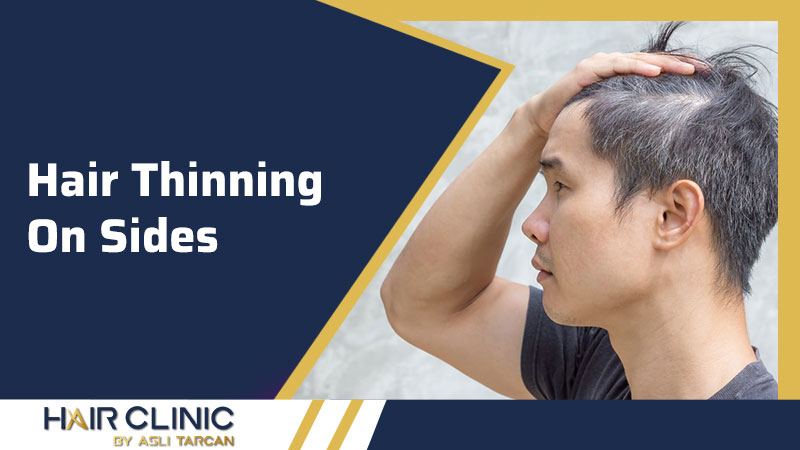Hair Thinning On Sides
Hair Thinning On Sides If you have female pattern baldness and your hair has been getting thinner in the last year, read it carefully. In recent months, not only the upper part of your hair but also the sides and back may be shedding. More than usual. You may feel like the back, sides, and tops of your hair are falling out and the amount of shedding has increased. You should definitely consider a treatment as your hair health deteriorates rapidly. Hair thinning on sides is a treatable disease.
The first thing we would ask you to consider, based on the information you have provided here, is when you first become aware of this increased hair loss. Next, think about what was going on in your life about three months before that.
Female pattern hair loss & hair thinning on sides
If you feel hair thinning on the sides of your scalp, this miscarriage is not related to women’s hair loss, as it only affects the follicles along the top of the head, from the hairline to the crown.
It seems likely that you are experiencing a temporary hair loss condition in addition to the permanent genetic hair loss you already know. This is known as Telogen Effluvium and not only can it cause the entire scalp to shed, but – in this way – it can make your existing female patterns look worse.
The common causes of Telogen Effluvium tend to revolve around issues that cause stress, either emotionally or physically. Key examples include feeling anxious or stressed, significant nutritional deficiencies, the presence of an underlying disease, or taking a prescription drug that mentions hair loss as a side effect.
Excessive hair loss
If there are other symptoms that are starting to cause you to lose more hair, it is worth talking to your doctor and possibly having a blood test if you do not have a condition that causes this excessive hair loss. We recommend that you check your iron and zinc levels at the same time. It is common for women, especially those with genetic hair loss, to be deficient in these nutrients, which can cause hair loss from Telogen Effluvium.
Once you have identified the cause, regular hair growth should be repeated within about three or four months. This should restore the hair in the areas around the neck and sides of your scalp to normal. While you will continue to lose your hair from the top of your head due to the diagnosis of genetic hair loss, the rate at which it falls will have to slow down – although this is not always the case. Telogen Effluvium treatment can be investigated and combined with hair loss solutions for women in many cases.
If you are interested in learning more about typical hair loss treatment options for women, the advice of an expert can provide you with personalized recommendations for clinically proven medicines and suitable hair growth support products, based on their findings.
These range from low light (LLLT) approved by the FDA to highly targeted nutritional supplements developed by our hair growth experts.
Look for possible causes
There may be an immediate explanation for local, partial thinning hair or bald patches (alopecia areata) only on one side of the head if you are looking for one. In some cases, the cause may not be so clear, but there may be possible explanations. The best thing to do is to visit your doctor, who may recommend that you see a dermatologist or other specialist to limit the possible cause or causes.
The following are some of the problems that could explain your unilateral hair loss:
Trauma Hair thinning on sides can be caused by trauma and can lead to inflammation or scarring of your scalp. For example:
- Hairstyles like tight braids that give more traction on one side of your head than the other
- Hair treatments such as conditioners, perms, or hair dyes that happen to burn or irritate one side of the hair or scalp more than the other
- Hairstyling tools, such as hot curling irons or hair straighteners, which can cause more damage to one side of your hair than the other, depending on how they are applied.
One aspect of attraction Some people subconsciously pull sections of their hair to one side only when working or resting. This can weaken and break the hair anywhere along the shaft or from the follicles. The culmination of this is a psychiatric disorder called trichotillomania – a mandatory, continuous pulling of hair.
Sleeping on one side Constant pressure and friction from your pillow on one side of your head while you sleep can potentially weaken the hair on this side and cause breakage and hair loss.
Systemic causes Medical problems generally lead to hair loss all over the head, but preferably and mistakenly they can start and attack weaker hairs or follicles on one side or the other. These include:
- Systemic lupus erythematosus, an autoimmune disease in which the body attacks itself
- Thyroid or other endocrine or immune diseases
- Some medications such as antidepressants, high blood pressure medications, or birth control pills
- Surgery, high fever, or chronic stress
Age Your hair becomes thinner as you grow older and you are more likely to start on one side of your head before the other.
Localized problems on the scalp These include diseases that can affect the scalp patches and cause you to scratch and break the strands of your hair or cause scars on the scalp and hair. These problems include:
- Lichens planus, a skin disease of unknown cause
- Psoriasis can affect only part of the scalp and cause scarring and hair loss
- Tinea capitis (or scalp ring) which is more common in children or other fungi could cause a local infection of the scalp leading to broken hair loss on only one side of the head
Circulation problems It is possible that a problem with circulation or inflammation in the blood vessels that supply blood and nutrients to the hair follicles on one side of your head could cause your hair to thin on that side.
The cause of triple hair loss may soon become apparent to you from this list. However, for some reason, the diagnosis may not be possible without consulting your doctor. By consulting our clinic, you can get more information about hair thinning on sides from our doctors and learn about the treatment methods.



